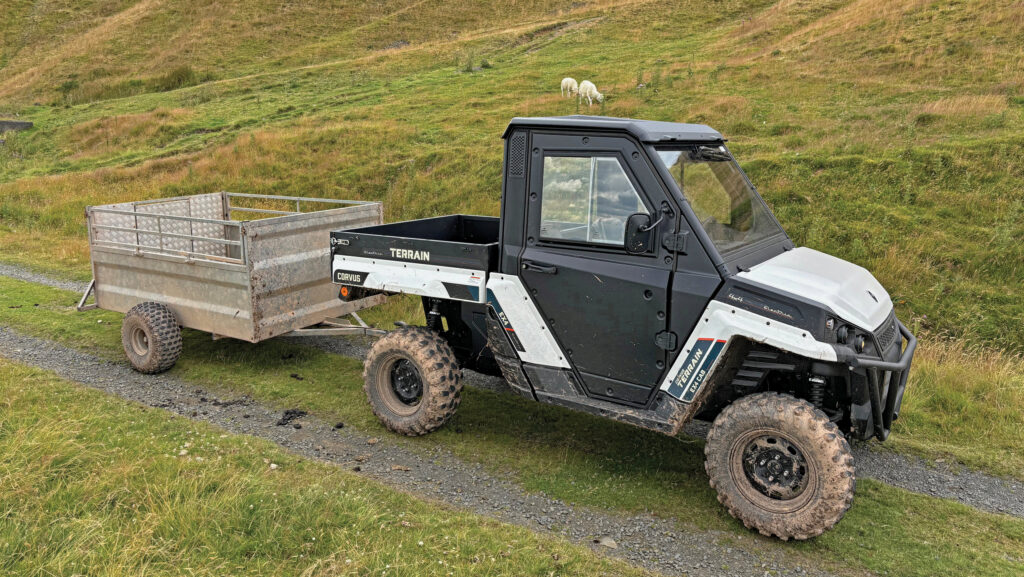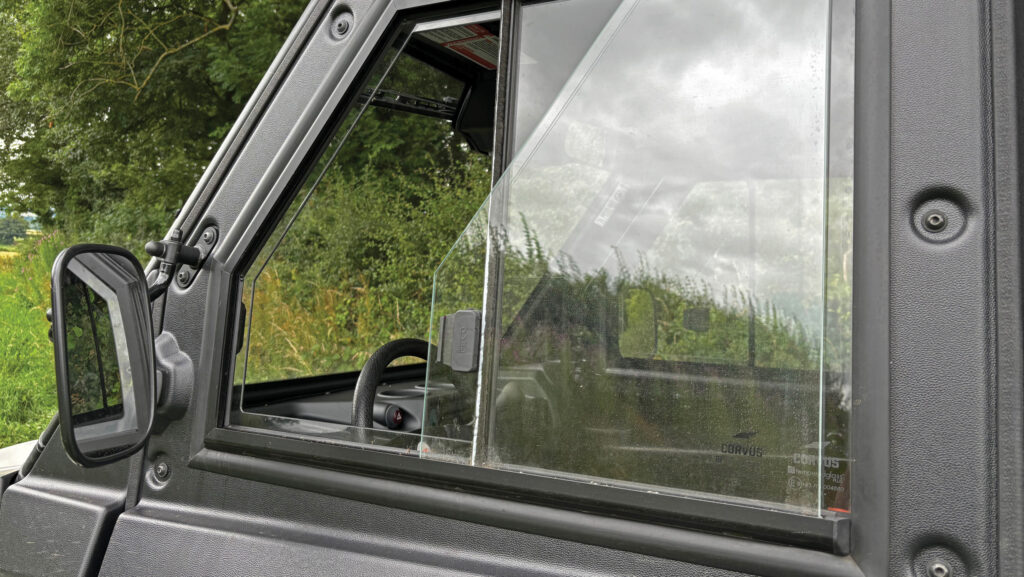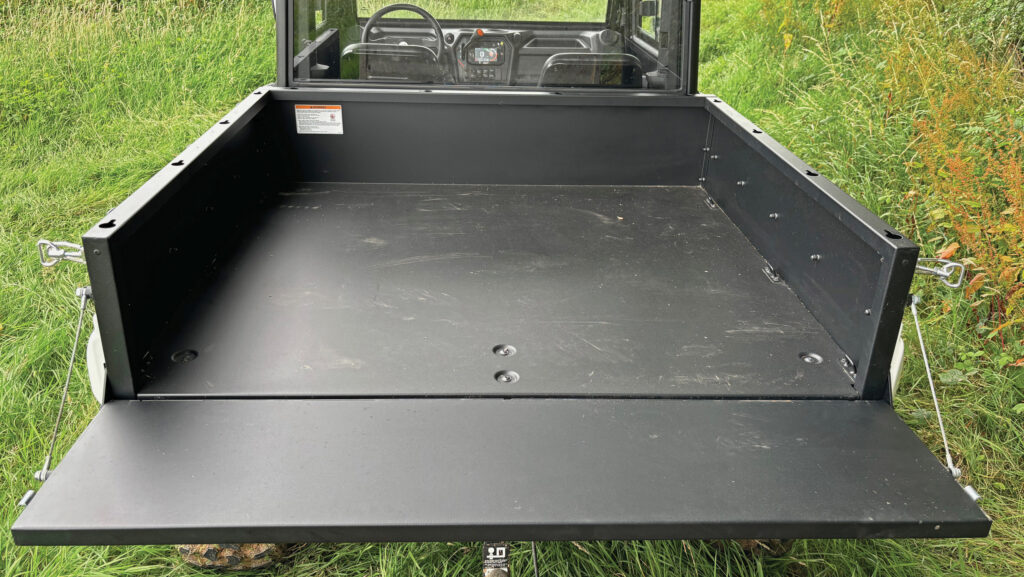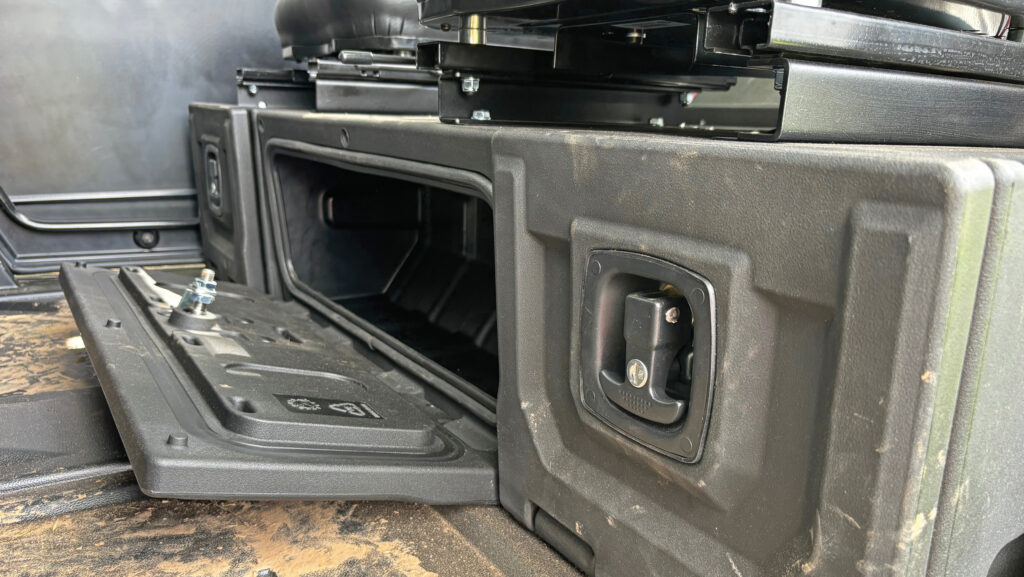On test: Electric Corvus UTV shows batteries have a way to go
 © James Andrews
© James Andrews Farmers have roughly the same appetite for electric vehicles as they do a vegan nut roast.
Which is why battery-powered UTVs such as Corvus’s Terrain EX4 need to knock the socks off their combustion-engined cousins in order to attract any sort of attention from agricultural buyers.
Key rival Polaris has already had its Ranger Kinetic reviewed earlier this year.
And though it impressed with its blistering acceleration, strong pulling power and quiet cruising, battery life was lower than expected and wet weather wreaked havoc with the charger.
See also: On test: Battery-powered Polaris Ranger XP Kinetic
For the EX4, Corvus has taken a different tack, fitting a far smaller 13kW motor which, in combustion engine parlance, delivers about 17hp.
Compare that with the 24hp served up in the diesel Terrain DX4, which itself is no firecracker, and this sounds rather pitiful.
However, the more direct delivery of that power, and the fact it’s backed up by 150Nm of torque, means acceleration is actually quicker.
It would have been simple for engineers to fit a livelier motor, but Corvus’s theory is that this would just eat battery life and isn’t required in a working vehicle.

© James Andrews
Corvus Terrain EX4 specs
- Motor 13kW (17hp)
- Battery 15kWh
- Top speed 40kph
- Range Up to 62 miles (Corvus figure)
- Cargo load capacity 300kg
- Max towing capacity 907kg (braked)
- Price £29,000 with full cab
Adequate performance
There’s some truth in this, as the electric drivetrain is moderately nippy off the mark, getting up to its limited top speed of 40kph in a respectable timeframe.
But the just-enough-power principle falls down slightly when you pile the weight on or hook a loaded trailer to the rear.
Flat ground isn’t much of an issue, but ask it to haul a load up an incline and forward progress will slow to walking pace. That said, it’s no worse than some diesel models in this regard.
So, with performance scraping into the adequate category, it would stand to reason that battery use is fairly frugal.
Corvus quotes a range of up to 62 miles, which indeed sounds ample.
But such is the way with these figures, it’s only achievable with achingly conservative driving at the hands of a featherweight pilot wearing nothing but their underpants.
Suffice to say, our testers didn’t satisfy any of these criteria, so range was consequently a fraction of the above.
It’s hard to determine exactly what fraction though, as our test model had the irritating habit of cutting out while the charge needle was showing half full.

© James Andrews
Battery life
The task of measuring battery life is a little more complex than taking a reading from a float in a fuel tank, and it can require multiple charge cycles for systems to calibrate properly.
But it’s far from handy when you’re four miles from home. As our test EX4 was straight out of the packing crate, we’ll give it the benefit of doubt.
One way of eking more range from the batteries is to make use of the lower power setting.
This is fine for pootling about at low speeds on easy terrain, although it lacks gusto for more serious tasks.
Mercifully, charging is a straightforward affair, involving plugging one end of the supplied lead into the machine and the other into a 13amp socket.
Regular top-ups are the key to getting the most from these vehicles but, if the batteries are run flat, they’ll take six to eight hours to fill completely.
Adapted from diesel
Like a lot of electric vehicles, the EX4 is based on exactly the same platform as its combustion-engined ancestor – in this case, the DX4 diesel.
So, where the engine and belt-type CVT transmission would normally sit, there’s now a neat drop-in unit including an electric motor, mechanical gearbox and battery pack.
This has been developed in conjunction with fellow Spanish outfit Alterity, which specialises in building battery systems for a range of off-road vehicles.
With no rubber belt to transfer the drive and minimal moving parts, power delivery is smooth and direct, making it a civilised machine to pilot.
That said, point it at some steep terrain with a bit of weight on board and it’ll occasionally voice its displeasure by letting out an ominous clunk.
Fortunately, the move to electric propulsion hasn’t marred off-road ability, with high and low ranges, switchable four-wheel drive and a rear diff-lock all on the billing.
Couple this with 309mm of ground clearance, plush coilovers on each corner and disc brakes all round, and you’ve got a capable machine.
Rated carrying and towing capacities are on point too.
Trailed implements weighing up to 907kg permitted, as well as a total payload of 620kg – 300kg of which can be put in the tipping rear load bed.

© James Andrews
No-frills interior
Just like the DX4 diesel, driver and passenger reside in a large, functional, but rather spartan cabin.
It’s a proper hose-out affair – there are even slots in the floor for water to drain away – so the most pungent of slurry-caked wellies will do no lasting damage.
Devoid of any sort of sound deadening, this workspace is a rowdy place to be on diesel models.
But there are no such problems with the electric version – in fact, this is one of its biggest selling points.
Another is a set of watertight lockers under the seats – ideal for storing a pair of trainers should you unexpectedly run out of battery and need to jog home.
Ventilation can be a touch wanting on a sweltering summer day.
With no opening windscreen, the only ports for funneling precious fresh air into the cabin are a pair of old-school Land Rover-style sliding door windows.
There is a perk to the fixed front screen, in that it’s available with an integrated heating element to keep it fog free in winter.
It’s a simple solution to an ongoing problem and does away with the need for an expensive, power-sapping heater unit.
Solid build
One area where Corvus doesn’t scrimp is its steel order.
Chunky box-section is used throughout the chassis, the swing arms look burly enough to handle a tank track and even the rear tub is pressed out of decent gauge sheeting.
The load area is big too – 1,340mm long and 1,203mm wide – eclipsing many rivals that make do with a far smaller plastic tub.
The only downside is that the painted metalwork bruises like a peach. So, for those that wince at the thought of it getting gouged and going rusty, some sort of bed liner will be a must.
Protection for the huge rear window wouldn’t go amiss either, as bulky cargo could soon have beads of glass cascading over the passengers’ shoulders.
Farmers Weekly verdict
Ask the EX4 to muck in on a busy hill farm or, God forbid, hand it to a gamekeeper, and it’s unlikely to shine. But it’s not alone.
Battery-powered UTVs have got plenty going for them – they’re smooth, quiet and often go much better than their diesel rivals.
However, load them with feed bags and point them up a muddy Welsh mountain and the batteries will fade considerably faster than the bumf will have you believe..
For those looking for a nippy farm runaround rather than an out-and-out workhorse, the EX4 could still be worth a punt.
All others are probably safer directing their attentions to the hardier DX4 diesel which, last time we tried it, was a decent piece of kit.

